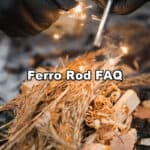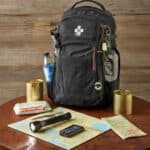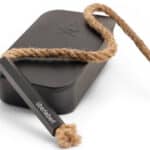Stealth camping is a way to set up camp in places that are not marked for camping, aiming to leave the smallest mark on nature. This method involves using tools such as hammocks with straps, small tents, or tarps to lessen harm to the environment.
With gear that’s light and easy to carry like dark backpacks, low tents, warm sleeping bags, and rain-proof clothes, stealth camping requires careful thought and planning. Choosing where to camp is crucial—look for spots that respect nature and avoid areas with lots of people or animals.
Remember the Leave No Trace rules: take all your trash with you, be gentle on plants and soil, keep away from water when using soap or going to the bathroom, and always be considerate of others enjoying nature.
Some places like White Mountain National Forest have their own rules for stealth camping which need checking before you go. Planning means knowing these laws plus finding good spots while steering clear of busy areas so we don’t hurt nature.
Stealth camping also means being quiet, keeping lights off at night unless needed, wearing colors that blend in with your surroundings,and making sure food smells do not attract animals.
Get ready for some smart tips on how to start prepping, and enjoy nature without leaving a trace!
Table of Contents
Understanding Stealth Camping
Moving from the basics, stealth camping is about setting up a campsite unnoticed. This means finding spots that aren’t meant for camping and staying out of sight. Campers use this method to sleep in places where there might not be official campsites or when they want to connect more deeply with nature—without leaving a mark.
The idea is simple: arrive late, leave early, and make sure no one knows you were there.
This style of camping needs gear that’s light and easy to pack up quickly. Think tents that blend into the surroundings, sleeping bags that keep you warm without bulk, and cooking equipment that won’t leave traces behind.
Stealth camping isn’t just about being unseen; it’s also about respecting nature. Campers avoid loud noises and bright lights to stay hidden but also to keep wildlife undisturbed.
It’s all part of the ethic—leave no trace—that guides those who choose this way of experiencing the outdoors.
Essential Gear for Stealth Camping
Packing light and right is key for stealth camping. Choose your gear wisely to stay hidden and comfortable outdoors.
Choosing the Right Shelter
For stealth camping, your shelter choice matters a lot. Go for hammocks with canvas straps, single-person tents, or tarps. These options are light and cause less harm to nature. They’re perfect for keeping a low profile while camping.
Your gear should blend with the surroundings. Pick colors that match the woods or wherever you plan to camp. This helps you stay unnoticed and protects the area around you. Choosing wisely means respecting nature and enjoying your adventure without leaving traces behind.
Proper Clothing Choices
After picking your shelter, the next step is choosing what to wear. Wear muted colors or camouflage to blend into nature. This helps you stay hidden. Your clothes should also be waterproof and windproof.
This keeps you dry and warm.
Pick comfortable hiking boots for walking on different types of ground. Think about wearing scent-reducing clothes, too. They help keep animals from noticing you.
Planning and Preparation for Stealth Camping
Planning for stealth camping starts with knowing local rules in places like the White Mountain National Forest. Check these before you pack, to avoid trouble. You’ll need a list of where you can find good spots to camp quietly and without harm.
This means areas that don’t squash plants or create paths others might follow. Your gear matters, too. Pick tents or shelters that press lightly on the earth. Think about using hammocks with canvas straps, small tents, or tarps.
Pack light but smart – essentials only. Bring a sleeping pad, flashlight, a DIY first aid kit, and right clothing to stay warm and dry. Planning means thinking ahead about how to be gentle on nature while enjoying your trip.
It’s all about leaving no trace so everyone can enjoy wild places as they are now and in the future. Preparation is not just what you bring but also how you plan to act – minimize noise, light, and your scent to blend into the surroundings for a peaceful experience.
Tips for Low-Impact Stealth Camping
Learn how to camp quietly, leave no trace, maintain mental health in crisis, and blend with nature to enjoy the wild without a heavy footprint. Discover more inside.
Minimizing Noise and Light
Keep the noise down. Move quietly. Use soft voices if you must speak. For light, avoid flashlights and bright camping gear. Choose tools with red or low-light options. This way, you won’t bother animals or draw unwanted attention.
Pick dark colors for tents and clothes. Stay hidden from both wildlife and people passing by. By doing this, your stealth camping trip stays secret and respectful to nature around you.
Being Mindful of Your Scent
Your scent can attract attention in the wild. Animals and people might notice you because of how you smell. Use unscented products before your trip to keep smells minimal. Avoid strong foods that could make your campsite more noticeable.
Change clothes if they get too smelly. Pack them away to keep the area around you free from strong odors. This way, animals or people will have a harder time finding where you are staying.
Blending into Nature
Blending into nature is all about being invisible. Pick colors for tents and gear that match the environment. Greens, browns, and grays work well in most places. Use a single-person tent or a tarp to keep your shelter small.
This makes you less noticeable.
Use hammocks with tree-friendly straps if trees are around. They leave less trace than tents on the ground. Always place your campsite where it blends in, avoiding open areas visible from trails or waterways.
The goal is simple – see without being seen, leaving the spot just as you found it.
Choosing the Right Location for Stealth Camping
Picking the perfect spot for stealth camping means staying unnoticed and blending into nature. It’s key to find a place far from busy areas and hidden from paths or trails.
Avoiding High Use Areas
Go for less walked paths while stealth camping. This helps the environment and keeps your campsite secret. Avoid places where many people go, like popular hiking trails or camping sites near Mounts Willey, in the Appalachian Trail, and the White Mountains.
These spots often have signs of heavy use, which can ruin your experience.
Stay clear of creating new trails. Doing so might lead others to follow, harming untouched areas. Search for pristine camping sites that show no sign of human visit before setting up your shelter.
This way, you help protect natural habitats and ensure a true stealth camping adventure without leaving a mark.
Observing Animal Tracks
Checking animal tracks helps find safe stealth camping spots. Tracks can tell you which animals are nearby. This keeps you away from dangerous areas. Look for signs of large animals or lots of activity to stay safe.
Next, consider the legal side of where you camp.
Legal and Ethical Considerations of Stealth Camping
Stealth camping has both legal and ethical sides to consider. It’s not just about finding a spot; it’s about respecting the land and laws.
Leave No Trace: Stealth Camping Ethics
Leave No Trace principles are key for stealth camping. They say you should camp without making a mark on the land. This means using hammocks with canvas straps, small tents, or tarps to cut down on how much you press down plants and the ground.
You must handle waste right, too — bury your poop in catholes away from water, pee on rocks or in mineral soil, and take all trash home.
Follow these rules closely to keep nature beautiful for everyone. Next up: Understanding Legal Boundaries.
Understanding Legal Boundaries
Knowing the law is key in stealth camping. Every place has its rules. For example, the White Mountain National Forest has specific regulations for backcountry camping. These rules are there to keep both campers and nature safe.
It’s a good idea to check these out before you set up your shelter.
You can find all you need about these laws on their website. This makes sure you’re not breaking any rules while enjoying your time outdoors. Always follow local guidelines to avoid trouble and protect the wilderness areas you enjoy visiting.
Conclusion
Mastering stealth camping lets you enjoy nature with respect. It teaches us to tread lightly and leave places better than we found them. Packing the right gear, choosing a smart spot, and following low-impact practices are key.
This approach ensures adventures remain secret, safe, and sustainable. Embrace these tips for your next trip into the wild—they make all the difference.







Leave a Reply